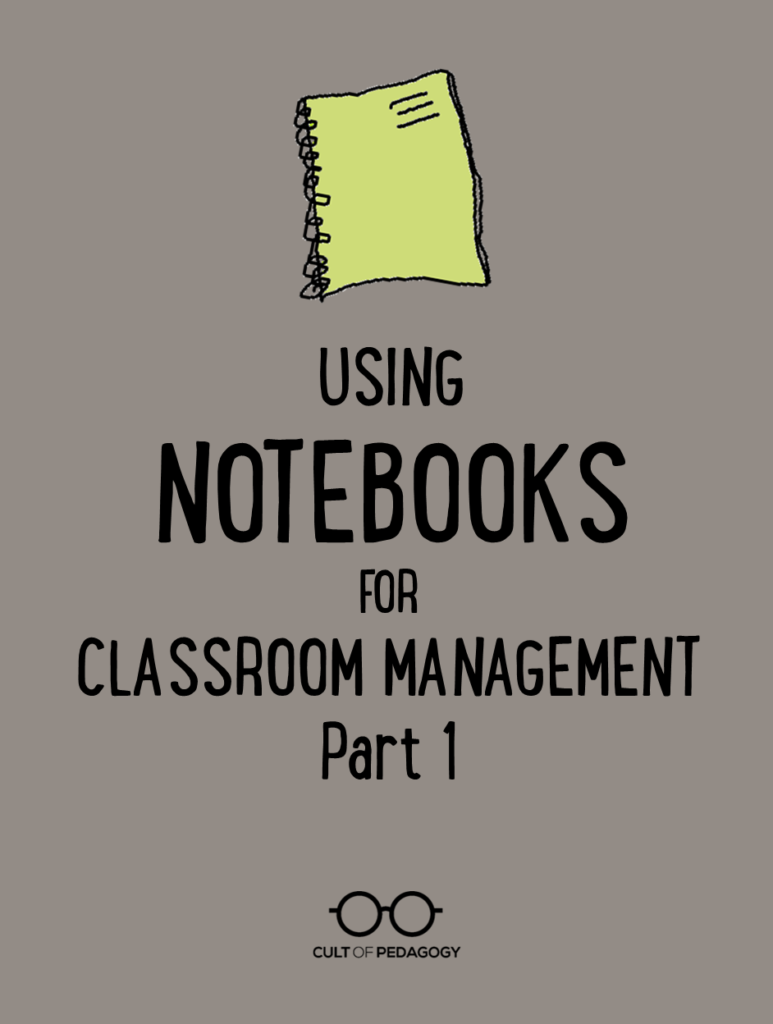
Ever have one of those days when your students are just out of control? Even if you’ve been teaching a while, you might still experience moments when all of your classroom management tools stop working. This one cheap, quick strategy, using a simple blank notebook, can help you regain control in under a minute.
Update: For more on this strategy, see Using Notebooks for Classroom Management, Part 2.
If you thought this was helpful, stick around.
Join my mailing list and never miss another post. You’ll get weekly tips, tools, and inspiration — in quick, bite-sized packages — all geared toward making your teaching more effective and joyful. To thank you, I’ll send you a free copy of my new e-booklet, 20 Ways to Cut Your Grading Time in Half. I look forward to getting to know you better!
Join my mailing list and never miss another post. You’ll get weekly tips, tools, and inspiration — in quick, bite-sized packages — all geared toward making your teaching more effective and joyful. To thank you, I’ll send you a free copy of my new e-booklet, 20 Ways to Cut Your Grading Time in Half. I look forward to getting to know you better!





Is there any way to host these videos on vimeo? My school doesn’t allow YouTube access and I’d love to watch it!
I’ll look into it. Until then, I hope you’re able to see it later at home!
Love this! I taught elementary school music for a couple years, and this would have saved my class on several occasions. I’m currently looking for another teaching job, and I’m glad to have this in my toolbox!
Hi Tess. Thanks for taking the time to comment. I’m really glad you liked this! If you ever find yourself using it in the future, come back and let me know how it goes.
Hi Jennifer,
Thank you for sharing your insights. I am a first year teacher and I really struggle with classroom management. I am definitely going to try the notebook method when things get unruly. Came across your website yesterday and am definitely going to work through more of your posts. Thank you for devoting time and energy into building this resource.
Hey Wynand,
I’m so glad you found the site! Classroom management can be such a beast, especially in the first few years. I hope the resources I have here are helpful. If you ever have a specific issue, feel free to contact me and I’ll do my best to find a solution for you!
I teach overseas, and I see a lot of teachers come and go. Our schools are high stress environments, and the students are so accustomed to teacher turnover that they see no point in attending to what the teacher is saying. As teachers, we are scared to stop mid-lesson, but this notebook trick has saved my sanity on more than one occasion! I’m sharing this video with incoming teachers in hope they’ll employ it rather than shouting or crying in class.
Hi Mimi ~ It definitely saved me on more than one occasion as well! I hope it helps your teachers. Thanks for sharing this!
I noticed when I would write in the middle of instruction, students were immediately worried who “was in trouble” and I would linger writing notes down. I can’t wait to try the notebook! Or to watch part 2. I teach grades TK through 8th grade and I have a feeling it will work for all ages. Any tips for different age groups? (Primary, elementary and middle school?) Thank you!
I do think this can work well for K-8, and am not sure there’s anything you’d need to do differently. Overall, age levels might respond differently, but the implementation and intent of this strategy would be the same. Keep in mind, this isn’t something you’d expect to be doing all the time or it might actually lose its impact. The goal is to have good classroom management, but when we have those moments when we really don’t know what else to do, when our own emotions are kind of running high, this can help us hit “reset.” The bonus is that it helps us be reflective, and we’ve got some data collection if we ever need it.
This works first and foremost because it makes the students worry that they are in trouble and that you are going to “report” to someone on their behavior. Even if you are doing it to write some thoughts of your own, the fact is that if you are putting the students first, this is a negative strategy in the perspective of the students’ interests. Don’t you feel like this goes against a lot of the philosophy you are writing about here?
Hi Jan.
This is an interesting point, and it’s a valid one: When I used this strategy, students did go on the alert. I’m sure for some, the thought crossed their minds that I was writing someone up, and they may have felt some fear. I present this strategy as a life-raft, a last-ditch effort, a healthier option than bursting into tears or screaming at students. It’s a solution for the teacher whose classroom management has gone terribly wrong–at least for the moment–and who has run out of alternatives. It’s a self-soothing strategy, a form of meditation, and what it can do is help the teacher get into a calmer state of mind so he or she can make a smart decision, rather than a knee-jerk one.
I guess it could be argued that it’s a negative strategy, that it’s not putting kids first, but I think a minute of student anxiety may be worth it for what they get in return: A demonstration of an adult who chose not to lose control emotionally, who self-regulated, using writing of all things to accomplish that. They don’t get the abandonment that one of my classes must have felt the day I simply left right in the middle of class to go cry in the bathroom (and this was my 4th year of teaching!), or the much greater anxiety one of my 6th grade classes must have felt during my first year when I threw a book loudly on my desk and screamed at them all to shut up. I don’t know if you’ve ever lost control with any of your students, but if you have, you’ll know that those moments can make indelible marks on your heart, on your confidence, and on your desire to persevere.
Yes, if a teacher has to resort to this notebook strategy on any kind of regular basis, that’s a sign that he or she lacks a more comprehensive approach to classroom management. But many teachers lack this. If you have a suggestion for an alternative approach to this kind of panicked, out-of-control feeling, I would love to hear it. I’m sure it would benefit any teacher who comes here for solutions. Thanks!
A healthy fear of a consequence to a negative behavior is not at all out if line. It will make the students think twice and produce more positive behaviors.
Hi Jennifer,
I teach middle school Japanese and most of the students that I’m teaching won’t continue studying Japanese next year. Therefore, their behaviour is horrible and they don’t care about calling parents or reporting to head of middle school. I have used this notebook but did not work at all. This is my first year of teaching and don’t have a mentor at school as my school don’t have a system for new teachers. It would be great if you could give me an advice.
Thank you!
Hi Jen!
It sounds like you are in a crappy situation. I would like to hear more about what happened when you tried the notebook strategy, so I can help you figure out why it didn’t work. You may want to look at Part 2 of this strategy for something that’s more systematic. It might do the trick.
In the meantime, it sounds like you might want to try doing some more relationship-building with your students. Developing strong relationships and getting to know your students well as individuals can take care of a lot of behavior problems. I have two forms, the Student Inventory and the How’s it Going form that both help you get to know students better, and the Deep Data at a Glance chart can help you keep track of what you learn.
You might also try the 2×10 Strategy, which sets up a schedule of informal teacher-student contact with your most challenging students…many teachers have reported seeing miraculous results after trying this!
Let me know if any of these work for you.
Jennifer, The notebook strategy is one I will be trying as a substitute teacher in elementary school. Even students in a well-disciplined classroom tend to “take advantage” of the sub b/c the consequences for their misbehavior are minimal. So, here’s hoping this will help as a “life-preserver” when everything is going wrong.
Excellent. Let me know how it goes!
I’m starting mid-year in a 1st grade ESE classroom. There are two paras in class, but that actually made me a little more nervous. I was feeling very beside my self- not knowing exactly where to begin. The principals words were hit the ground running & sink or swim. I want to thank u for this comprehensive outline It really made me feel a great deal more prepared for situation. I look forward to reading a lot more!
I had some interesting results with this. I used this in my 3 periods of 7th grade math and 1 period of advanced 7th grade math. It was pretty effective in my highest-performing Math 7, and it was immediate in my advanced 7th. The other two periods are a challenge because there are so many very talkative kids that feed off of each other. For my worst class, the two most disruptive would still not acknowledge it – but I still had hopes. The next day the two students told me we were behind because I had spent “half the period writing in that stupid notebook instead of teaching” them what they needed to know.
My overall conclusion is the notebook is very effective with motivated students, but I was naive to think it would magically stop my most talkative students in one day… I think it is a good tool, and I want to try to get comfortable using it so I can start incorporating the ideas from the Part 2 video, but I think I’ll practice on selective classes!
This seems like a great self-soothing strategy.
What would you say to students who ask you what you’re writing? Do you tell them you’re writing down what’s happening? This might lead to more negative behaviors, but I think it may be awkward to tell them you’re writing down your feelings. Then again it could be a teachable moment about how to deal with stress in healthy ways. But then I worry it wouldn’t fix the behavior and even encourage them to be disruptive even more.
How do/did you handle the question that I got from students nearly every single time that I began writing anything, anywhere, during class?
“Mr. Stricklin! Are you writing MY name down? Are you writing a referral?”
Often times, I would simply refuse to answer the question, so they’d follow up with an assumption, “But I wasn’t doing anything!”
Once or twice I mentioned that, more often times than not, a student asking me those questions do so out of a sense of guilt, indicating to me that they were aware they were misbehaving, and were trying to weasel out of the consequences. Sometimes, I wasn’t even writing about them.
So what do you do? Ignore the questions? Discuss it beforehand?
Wow, where was this when I needed it last year? I can’t wait to use this and see how it works in my own classroom.
Glad you liked this, Cody!
Tried this strategy today and it worked wonders! Getting class started without all the talking and having students on task during the class warm-up has been a challenge this year. Thank you for the great idea! Will be sharing with my Facebook friends!
I tried this strategy and it work wonders, thanks for the idea.
Thank you for taking the time to create these blog/podcasts! They are invaluable for me as a first year teacher who is about to take over a class after school has been in session since August!
Hi Audrey, Thanks for writing in. I will be sure to share your message with Jennifer. Best of luck in your first year!
Thanks a lot for sharing my idea , I thought. The notebook trick does wonders. It scares students in the most sensitive and freighting ways. However, it is very effective. I’ve been teaching for over 20 years.
Darrick, I’m glad you’ve found this particular strategy to be effective! However, the goal of the strategy is not to frighten students. Is there a certain part of the video that suggests this? If so, we’d love to know. This is a pretty old post, and it may be something that we need to revisit. Thanks!